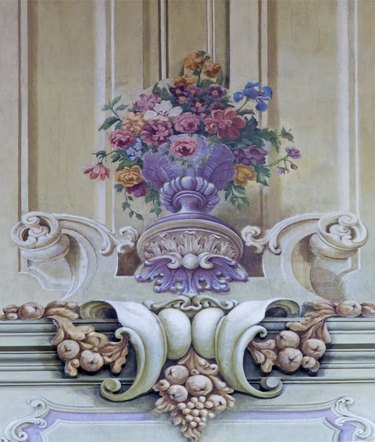
Floral arrangements morphed in style throughout the baroque period, which lasted from the late 16th century to the early 18th century. Early Baroque designs were influenced by artists, as flower arranging had not yet been established as an art form. Tall, massive oval shaped arrangements featured abundant flowers. Later in the period, arrangements transitioned toward asymmetrical curved designs in crescent C and S Hogarth shapes, refining the massive designs into more graceful and dynamic styles. Floral paintings conceived by Flemish artists were more compact with a better sense of proportion.
Style
Video of the Day
Baroque-style flower arrangements are characterized by a massed combination of mixed flowers and foliage, creating an elegant, overflowing display. They range in style from extravagant and asymmetrical to simple and symmetrical. Arrangements in the beginning of the baroque period were symmetrical oval shapes. They transitioned into soft asymmetrical triangle shapes. The arrangements showcase upright flowers combined with drooping flowers and foliage that gently cascade out and down. Although the style was at times exaggerated, the arrangements were never overdone to the point of excess. The arrangements always maintained a soft look to them. The English artist William Hogarth introduced the "S" shape, also known as the "Hogarthian curve," which became a popular arrangement shape. The "S" shape is still seen in arrangements today.
Video of the Day
Flower Choices
A large variety of flowers are used in baroque-style arrangements. Popular flower choices during the baroque period include carnations, sunflowers, roses, poppies, peonies, marigolds, lupines, lilies, lilacs, canna and narcissus flowers, larkspur and hyacinth flowers, irises, foxgloves, hellebore and hollyhock flowers, cyclamen and nerine flowers and snowball-shaped flowers. A combination of different types mix together to complement one another and create visually-appealing arrangements. Popular foliage used in baroque-style arrangements include the leaves of flowers used and coleus and olive stems and leaves. Large, bold leaves belonging to hosta, castor bean and canna plants are also used.
Fruit
Fruit is sometimes included in the arrangements. Apples and pears are popular choices. Grapes with leaves and tendrils are often included. Cherries, peaches and strawberries with the leaves attached are also popular choices to include. They may be strategically placed in the arrangement or merely sit along the top of the urn or basket opening.
Accessories
Baroque-style flower arrangements are often accompanied by decorative accessories that sit next to the arrangement. Vegetable or fruit bowls may be set near the bouquet, or decorative birds' nests with eggs. Shells, jewels and coins may decorate the bottom perimeter of the vase. Figurines, cups and plates are also popular accessory choices, particularly porcelain varieties to complement Chinese or Japanese vases. Nuts, berries and cones support a natural look. House Baroque arrangements in urns, tall vases and low baskets.